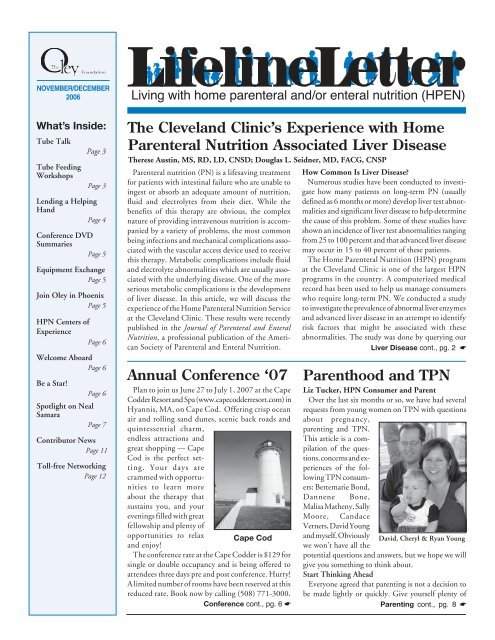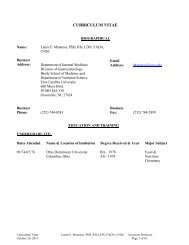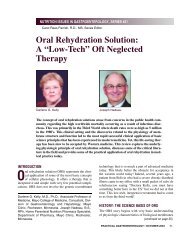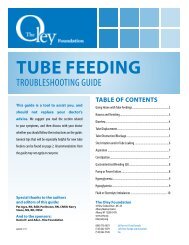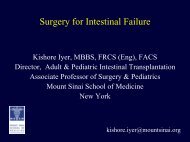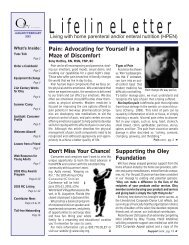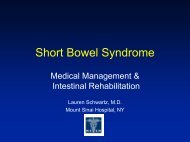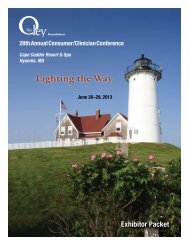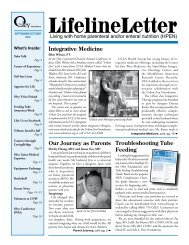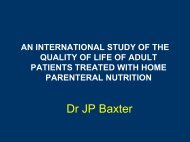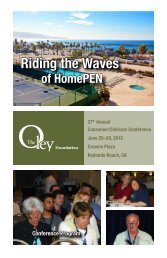LifelineLetter - Oley Foundation
LifelineLetter - Oley Foundation
LifelineLetter - Oley Foundation
You also want an ePaper? Increase the reach of your titles
YUMPU automatically turns print PDFs into web optimized ePapers that Google loves.
<strong>Oley</strong> NewsLending a Helping Hand<strong>Oley</strong> has many volunteers who generously give of their time andtalents to support <strong>Foundation</strong> programs. Some take the toll-free lineeach month, Regional Coordinators offer education and support,while others write articles for the newsletteror help organize conference events.Here we’d like to offer a special thanksto our “behind the scenes” volunteerswho help at the <strong>Oley</strong> office.Nancy Linsley has come to the <strong>Oley</strong>office every Wednesday, since Ellie Wilson(former Outreach Coordinator) firstintroduced her to us four years ago. Shehelps the <strong>Oley</strong> staff by addressing thehundreds of information requests weNancy Linsleyreceive each month. Nancy is also instrumentalin getting out large mailings,and preparingstaff materials for special events. Sheis loads of fun and raises our spiritstremendously.Blanche Hoffman is another terrifichelper who volunteers at the officeregularly, doing mailings and the like.In addition to her sense of humor,Blanche offers the understanding thatcomes with living with a husband whohas been on tube or IV therapy for morethan ten years. We are so happy to have heron board!Joyce Hydornstaff and many <strong>Oley</strong> members. Marjoriehas worked on a number of projects in theoffice, and helps out at the annual conferenceand local events too. She attendedher first conference in 2003and has helpedat every conference since – donating hertime as well as paying her own travelexpenses! She is very dedicated to <strong>Oley</strong>.We are grateful to all of our volunteersfor their many contributions. Truly wecould not run <strong>Oley</strong> without you.Blanche HoffmanA third volunteer, who helps out inthe office whenever we have specialprojects, is Joyce Hydorn. Joyce and herhusband Bob have also been a big help atlocally-held events and conferences. Joyceis a long-term TPN patient, and beganvolunteering after her health preventedher from working full time.A good friend of Joan Bishop, (<strong>Oley</strong>’sExecutive Director,) Marjorie Quinnhas a warm personality that’s endearedher to therest of theMarjorie Quinn4 — <strong>LifelineLetter</strong> • (800) 776-OLEY November/December 2006
<strong>Oley</strong> NewsSummaries of ConferenceSessions AvailableSummaries of the 2006 <strong>Oley</strong> Conference sessions that were filmedfor DVD are available. Sessions include: What Is Rational Management?,Being All That YouCan Be, Reducing HPNDependency, What AreProbiotics, MicroNutrients,and the History and Futureof HPN. The summaries canhelp you decide which DVDyou’d like to borrow fromthe <strong>Oley</strong> Library.Summaries of other <strong>Oley</strong>DVDs/videos are cominglater in 2007. To read the summaries or order the DVDs, visitwww.oley.org or contact Cathy Harrington at (800) 776-OLEY.Equipment ExchangeNewly available items offered free of charge include:Formula:• 3 cases Complete, exp.4/07• 6-7 cases Elecare Pediatric Formula (powder), exp. 8/07• 3 cases Jevity 1.2, exp. 7/07• 5+ cases Jevity 1.5, exp. 8/07• 3 cases Fibersource HN, exp. 11/07• 4 cases Glucerna, exp. 1/07 & 4/07*• 2 cases Osmolite 1 Cal, exp. 7/07• 9 cases Osmolite 1.2 Cal, exp. 4/07*• 5+ cases Pediasure, vanilla, exp. 7/07 & 8/07*• 14 cases Peptamen, exp. 7/07 & 8/07• 4 cans powder, Portagen, exp. 8/07 &1/08• 6.5 cases Promote with fiber, exp. 3/07• 2 cases Promote, exp. 1/07• 3 cases Pulmocare, exp. 3/07• 4.5 cases Traumacal, exp. 2/07 & 9/07Bags/Tubes:• 17 Kangaroo 1000 ml bags• 30 Kangaroo gravity feed sets, 1000 ml, #8884702500• 30 Ross Easy Feed Enteral Bag, 1000 ml, #56• 1 Viasys enteral feeding tube w/o stylet, 8 Fr., 36”, #20-1368• 56 Zevex Infinity 1200 ml bags, #INF1200**multiple donorsDon’t Miss Us in Phoenix!Start the new year out right by joining <strong>Oley</strong> on January 27,2007 in Phoenix, Arizona! This one-day regional conference willshow you what’s new in homePEN therapy for 2007. Topicsinclude the emergent therapies, Pre/Probiotics, as discussed by KellyTappenden, RD, PhD and Growth Factors:GLP2 and Teduglutide, coveredby Palle Jeppesen, MD, as well as ComplicationsAssociated with Vascular Access,by Sheila Messina, RN. Roundtablesessions will be hosted by Lyn Howard, MDand Jane Balint, MD, on Pediatric Issues; Kishore Iyer, MD,on Intestinal Failure; Doug Seidner, MD, on AvoidingComplications; and Sheila Messina, RN, on Sharing from theConsumer Perspective. Registration begins at 9:00 a.m. andthe program will run from 10:00-4:30 p.m. Walk-ins arewelcome. Stay tuned to www.oley.org for the exact location ofthe conference and for program updates.<strong>Oley</strong>’s conference has been developed in conjunction with theannual meeting of the American Society for Enteral and ParenteralNutrition (A.S.P.E.N.). A.S.P.E.N.’s “Clinical Nutrition Week”runs from January 28-31 at the Phoenix Civic Plaza. We inviteyou to join us there too by volunteering at <strong>Oley</strong>’s booth inA.S.P.E.N.’s exhibit hall. Don’t miss this rare opportunity to beamong hundreds of exhibitors showcasing their newest products.Volunteers are needed January 28, 29 and 30 to work oneor more shifts at the <strong>Oley</strong> booth from 9:30 a.m. to 11:15 a.m.,12:15 p.m. to 1:45 p.m. and/or 3:00 p.m. to 4:15 p.m. each day.For more information or to volunteer, contact Kate Swensen at(800) 776-OLEY or email Swensek@mail.amc.edu.MORE SUPPLIES are available! Visit www.oley.org, or contactour volunteer, Ben Hawkins (benhawkins@fuse.net; toll free 866-454-7351). This number reaches Ben’s home, so PLEASE, CALLBEFORE 9 P.M. EST! (Not CST as incorrectly printed last issue.)<strong>Oley</strong> cannot guarantee the quality of the supplies donated or beresponsible for their condition. We ask that those receiving goods offerto pay the shipping costs.Volume XXVII, No. 6 (800) 776-OLEY • <strong>LifelineLetter</strong> — 5
Regional NewsHPN Centers of ExperienceBecause of the complicated nature of home parenteral nutrition (HPN),the potential for serious complications is always a concern. This columnis meant to highlight the institutions around the country that specializein caring for HPN consumers. At least one study has shown thatconsumers who are treated by programs specializing in HPN have betteroutcomes. <strong>Oley</strong> does not endorse any center but brings this to ourconsumers strictly as an informational tool. For a listing of otherexperienced centers visit www.oley.org.University of California, Los Angeles Medical CenterThe Home Parenteral Nutrition (HPN) program at the UCLAMedical Center was founded in 1974 by Dr. Marvin Ament. Theprogram was the first of its kind in California and serves both pediatricand adult patients. Consumers are seen in a designated PN clinic,where besides receiving care from an expert multidisciplinary team ofphysicians, RN specialists, a social worker, dietitian and pharmacist,there are opportunities for meeting other HPN consumers.The team at UCLA cares on average for 70 to 75 HPNconsumers, as well as individuals who are supported on enteralnutrition or who have successfully been weaned from PN. Theteam has a strong commitment to consumer and caregivereducation, advocacy and support. Quality of life issues forconsumers and caregivers are a strong team focus.The UCLA Medical Center provides a full range of experiencedmedical and surgical specialists to support the special needs of theHPN population. The UCLA Homecare Pharmacy was one of thefirst homecare pharmacies in Southern California and continues as anexperienced provider of HPN and other home infusion therapies.In 1991, the UCLA Intestinal Transplant program was foundedunder the direction of Dr. Douglas Farmer, completing the full scopeof services available to individuals with intestinal failure. For moreinformation regarding the HPN program at UCLA contact LaurieReyen, RN, MN (310) 825-4823 or nsler@mednet.ucla.edu.Welcome Aboard!Please join us in welcoming our two newest Regional Coordinators:Shannon Curran (HEN) — Ontario, CanadaShannon began using her first j-tube at the age of 16. Now 27, shestill uses a j-tube but is currently waiting for a MIC-KEY. Shannonfeels she is a very good troubleshooter. She also has been surprisedthat so few Canadians really know anythingabout HEN and <strong>Oley</strong>. Shannon ishoping to educate Canadians and enhanceOLEY’s presence in Canadathrough a variety of seminars and meetings.She is available to talk and offer herinsights to new users as well. Shannoncan be reached at (705) 728-6123 orshannon122122@hotmail.com.Joseph Rodgers (HEN) —New Bedford, MAShannon CurranAs a teenager, Joseph was diagnosedwith Achalasia, a rare and degenerativedisorder of the esophagus. Joseph experienced progressive difficultyswallowing, until the year 2000 when his esophagus finally had to beremoved. He temporarily relied on a j-tube immediately following thesurgery, but was unable to thrive once it was removed. His j-tube wasreinserted permanently in 2005. Joseph is a consumer who does “notmiss eating at all.” Joseph goes to work as an RN while hooked up toa portable pump. He and his wife, Robyn, are raising 3-year old autistictwins and he tries to spend as much time as possible with his family.He is a motivational resource for consumers. Joseph can reached at(508) 999-7363, or JMR12667@aol.com.Be a Star!Your face could be the new face of <strong>Oley</strong>! Send us picturesof YOU doing what you like best: hanging with friends andfamily; biking, hiking or another activity; with or without your tubes/IVlines showing. You can also shape <strong>Oley</strong> materials by telling us how <strong>Oley</strong>has helped you and more importantly, how oley can help you better.Let us know what is working and what needs fixing or creating. Wewant to hear from you! Send your photos and ideas toDahlR@mail.amc.edu, or The <strong>Oley</strong> <strong>Foundation</strong>, 214 Hun Memorial,MC-28, Albany Medical Center, Albany, NY 12208. Be sure to includeyour name, daytime phone or email address, permission to print / postthem on the web, and your home address if you want prints returned.Conference, from pg. 1To secure this reduced rate be sure to let the reservationist knowthat you are attending the <strong>Oley</strong> conference and be sure to indicatewhether you will need a refrigerator and/or handicap accessibility, orif stairs present a problem. Questions? Need additional information?Call us at (800) 776-6539.As always we invite you to send along suggestions regarding topicsyou’d like to see covered and/or recommendations for speakers.6 — <strong>LifelineLetter</strong> • (800) 776-OLEY November/December 2006
Spotlight on Neal Samara, a Jordanian TPN ConsumerLiz TuckerThis past July during an appointment at the Mayo Clinic, myphysician, Darlene Kelly, MD, asked if I would talk to a new TPNpatient at St. Mary’s Hospital. I agreed, and so she introduced me toNeal Samara, the TPN patient, and her father, Dr. MohammadSamara from Amman, Jordan.We spent almost two hours together. Neal and her father askingquestions about different aspects of living with TPN; while I askedquestions about Neal’s historyand how she came to be onTPN. She is married and herhusband is an engineer for a I was more and more impressedmajor company in Amman. with her positive attitude and hardThey have five children, twogirls and three boys, ranging in work to make sure she could doage from nine to sixteen. It was TPN once she got home.obvious she was very proud ofher family.Differences in CareNeal had a thrombosis in the mesenteric vein that resulted ingangrene in her small bowel. Surgery removed all but one foot of hersmall intestine. Luckily her large intestine was not affected. Theoriginal surgery occurred ten months previous to her trip to the US.When she went home she wasn’t able to maintain her weight and hadto be hospitalized again. They inserted a catheter and put her on TPN.She told me a number of things about TPN in Jordan are very differentfrom here in the U.S. They don’t mix all the components together inone bag but instead give a number of small bags with differentcomponents over the course of the night. For example,dextrose would be in one bag, lipids in another,potassium in a third, etc. Because of that, TPNis not done at home, only in the hospital.The second big difference has to do with the catheter.Neal told me that the care given her Hickmancatheter was much different than what she was taughtto do at the Mayo Clinic. The emphasis is not onsterility. Consequently Neal got a blood infectionand had a fever over 104 degrees for two weeks whilethey gave her intravenous antibiotics. Her fever didnot go down until they pulled the catheter. Neal hadspent four of the last ten months in the hospital andshe was still very underweight. It was at that pointthat her father decided she should come to the MayoClinic in Rochester, Minnesota.Forging a FriendshipDr. Samara is a highly regarded pediatrician inAmman, but getting a visa from the United States tobring Neal to Rochester was difficult. Once at Mayo,Neal was hospitalized because she was so emaciated. Tests were doneand once she was stabilized a new catheter was placed. I met she andher father a week or so after she started her training to take care of hercatheter and do TPN at home.Neal and Dr. Samara’s questions for me ranged from how long I hadMember Profilebeen on TPN, to whether had I traveled, to what were the problemswith doing TPN at home. They were in awe at how healthy I looked.As luck would have it, three days later I ended up at St. Mary’s witha blood infection of my own. Our rooms were across the hall fromeach other and we spent a great deal of time together walking thehalls, sitting outside and just talking. I was more and more impressedwith her positive attitude and hard work to make sure she could doTPN once she got home, as well as her father’s unwaveringsupport and help whenever she needed it.Long-term SolutionsDr. Kelly did a tremendous amount of work finding asource for a premixed TPN solution that would work forNeal, and then a doctor in her region who would be ableto carefully monitor her condition. Because the thrombosiswas caused by a hereditary blood problem, Nealhas the added complication of having to take significantdoses of cumadin.Neal and her father stayed an additional month inRochester so she could take human growth hormone (HGH)shots. The hope is that the HGH will help her one foot of smallbowel absorb better so she won’t need quite as much TPN.Building BridgesAfter my hospitalization I drove down at least once or twice a weekto take Neal and her father shopping, to take pictures of the MayoClinic and just talk about our lives and the world in general. Theytold me several times that their impression of the United States waschanged dramatically by coming to this country and their experienceswith the peoplehere. They both saidthat without exceptioneveryone they met hereor who had taken careof Neal in the hospitalwas kind, generous andhelpful. They werealso amazed by the factthat so many peoplehere smile. People inJordan don’t smilenearly as often; particularlynot at otherpeople when they areout in public. Beforethe end of their stay,Dr. Kelly and hermother, Dorothy,brought Neal and Dr.Samara to my house for a visit. Neal and Dr. Samara brought all theingredients needed to make a real Arab meal. It was wonderful.Neal and her father have returned to Amman, but we plan to keepin touch. They are wonderful human beings and it is a privilege tocall them friends.Neal Samara visiting Liz Tucker in Minnesota this summer.Volume XXVII, No. 6 (800) 776-OLEY • <strong>LifelineLetter</strong> — 7
Coping SkillsParenting, from pg. 1time to make your decisions. There is a great deal to think about. Oneof the first questions is whether you can carry the baby yourself. TPNshould not, in and of itself, be a barrier. The medications you take foryour underlying condition, however, could bea problem. This is one of those very importantquestions for your doctor. It may be possibleto change to another medication, lower thedose or even go off the medication during thepregnancy/nursing period.Similarly your underlying disease or energylevel may present a significant obstacle. Oneparticipant spent the entire nine months shewas pregnant with nausea and abdominal painand it didn’t go away until right after her babywas born. One of the others, not only didn’thave any nausea; she actually felt her underlyingdisease was much better while she was pregnant. Another of ourparticipants talked about how helpful her homecare company wasduring her pregnancy. They worked closely with the doctor to makesure both she and the baby were getting enough nutrition. The resultwas a healthy baby. As with a person who is not on TPN, everyone’spregnancy experience can be different.Another consideration if you want to carry the baby yourself, iswhether your underlying diagnosis is hereditary. This has been avery difficult issue for some patients and their families. Geneticcounseling should be done before you make any decisions. Oneof our participant’s and her husband believe that is a good ideaand are already working with a geneticist to determine anypossible impact should they decide to try pregnancy.What are the chances that your disease or being on TPN will affectthe pregnancy or your long-term life expectancy? If the answer issignificant, you need to face the possibility oflosing the baby or, after the baby’s birth, thebaby losing you. Because she had lost a childdue to her underlying condition, one participantgave up on ever having any children. Atage 44 she became pregnant and one of herconcerns was how would it affect her child ifshe were to die before she became an adult.After very serious thought she decided shewould just be the best mother she could beDannene Bone with her son at the <strong>Oley</strong> and if something unforeseen happened sheconference in Salt Lake City.would have faith that her child would be okaywith one parent. After all, there have beenmany children in this world who have lost a parent and grown up tobe healthy, happy and productive human beings.Other OptionsIf you are not able to carry your own pregnancy to term, or have ahereditary disease, surrogate birth mothers, adoption and foster careare options, though they each come with a different set of issuesSurrogate MotherDo you have a person you know and trust to be a surrogate birthmother for you? One of our participants has a sister who has offered tocarry the baby. Other people have needed to go outside of theirNutrishare's Ad8 — <strong>LifelineLetter</strong> • (800) 776-OLEY November/December 2006
families. There are hefty financial costs to consider as well: fertilitytreatments, harvesting of your eggs, invitro-fertilization, implantationof the eggs and medical care for the surrogate mother, to namea few. Don’t forget the physical considerations of these actions aswell. They can be very taxing on the body. Finally, there aresignificant legal and psychological issues regarding having someoneelse carry your child that should belooked into and dealt with before youstart the process. In addition to yourphysician and family support, you willlikely need to retain a lawyer and possiblya counselor as well.AdoptionAdoption gets around many of thephysical obstacles; however, with theexception of minority and disabled children,adoption in the US can be a long and expensive process.There just are not enough healthy babies to go around. Because ofthat, many couples have looked to countries in Eastern Europe, theFar East or Africa for babies to adopt. There can be many regulationsand a significant amount of money involved to adopt childrenfrom these areas. In addition, in some cases parents have adoptedsupposedly healthy children only to bring them home and find theyhave very serious health issues. Can your support system handle asecond chronically ill person?Foster ParentBecoming a foster parent also gets around the physical issues associatedwith pregnancy, but comes with other risks. Because manychildren in the fostercare system comefrom problem or dysfunctionalhomes,being mentally andphysically equippedto care for one of thesechildren is essential.You also have to beprepared to give thechild back to theirbiological family ifCandace Verners celebrating Christmas withher family.Having a child may not have curedtheir illness or allowed them to get offTPN, but participating in theirchildren’s lives and watching them growhas only been a positive experience.there is a positivechange in their homesituation. One of ourparticipants is looking at the possibility of taking on a school-age fosterchild to overcome the energy issues of pregnancy and caring for asmall child, as well as the expense of all-day childcare (she works). Shewill still need a solid support system for those times when the childmay be ill, she may be ill or hospitalized or, as a single parent, thosetimes when she feels the total weight and responsibility for bringingthis child up and needs a break.Quality of LifeHow might the pregnancy and then the baby affect your quality oflife? Every parent involved with this article said that having childrenhas enhanced their quality of life. They look forward to getting upevery morning and watching their children grow.Coping SkillsAre they a great deal of work and consume a tremendous amount ofenergy? Of course. Are there future complications (fatigue, relapse ofyour disease, surgery, infections, obstructions, etc.) that might impactyour ability to parent your child? Again, this is almost a certainty. It isapparent from all the stories gathered for this article that having astrong support team assembled is a must, but can help you realize yourdream of having children. Being able tocount on your husband, parents and/or siblings,in-laws or some of your friends is veryimportant. The in-laws of one young womanhave offered to add an addition to theirhome. It would be a place to stay when theyneed help with the baby. How much yoursupport team can handle is a considerationtoo. The one father who helped with thisarticle had undergone transplant surgery andwas so looking forward to the time when he would be able to take someof the responsibility for their child off of his wife’s shoulders.In summary, everyone who contributed towards this article expresseda similar sentiment though in a number of different ways. They all feltthat having a child may not have cured their illness or allowed them toget off TPN, (and they still had problems occur because of those things),but participating in their children’s lives and watching them grow hasonly been a positive experience. As one parent said “It helps us see theworld as something bigger than ourselves. We are not just our disease andnot just a person on TPN. We are a parent, and being involved with ourchildren means being involved in a larger world.”As you can see, many of the questions and concerns are not thatmuch different than the average person, there are just more of themfor those of us on TPN. Addressing them ahead of time can keepthe unpleasant surprises that come with pregnancy and parenthoodto a minimum. We hope our experiences will help you if you arethinking about becoming a parent.Volume XXVII, No. 6 (800) 776-OLEY • <strong>LifelineLetter</strong> — 9
Medical UpdateLiver Disease, from pg. 2(AST and/or AP), 161 (99%) had abnormalLFTs (bilirubin, albumin and/or PT) and onlyone patient had normal liver tests. Closer inspectionon an individual basis revealed that mostabnormal liver function tests were in the mild ormoderate range. The high rate of LFT abnormalitiesreflects the fact that one of the measuresused to define LFTs is albumin, which isalso a marker of nutritional status. When albuminwas removed from our definition of LFTsthe rate of abnormality dropped to 57%.Despite this seemingly high rate of liver testabnormality, only seven of the 162 (4.3%)patients had severe liver dysfunction. Afterreviewing the records of these patients wefound only one instance where severe liverdysfunction could be attributed solely to theuse of PN. We also found that female genderwas associated with a greater likelihood ofdeveloping liver failure. Because only sevenpatients developed severe liver dysfunction andsix happened to be women, it is possible thatthe association between gender and liver failurewas by chance alone and not a true result.What to Look ForThe study also assessed individual patient’sPN formula. They received an average of 24.7total calories per kilogram per day and 18.5calories per kilogram per day of dextrose.Approximately 10% of total energy was suppliedas intravenous (IV) lipid emulsion. It isour practice to provide patients with IV lipidonly one or two times per week to meet theiressential fatty acid requirement. Daily IVlipid emulsion is reserved for patients withdiabetes or elevated blood sugar levels that arenot easily controlled by adding regular insulinto the PN formula. In our study there was atrend for a higher dose of PN calories, dextrosecalories and a greater duration of PN tobe associated with worsening liver enzymeabnormalities. This observation was not statisticallysignificant; however, other studieshave found an association between these factorsand liver failure. It is possible that thesefactors did not reach statistical significancebecause our patients were not exposed to PNfor as long as patients in these other studies.There are several theories as to why patients onPN have abnormal liver associated enzymes orliver function tests. It may be due to a nutrientdeficiency or toxicity in the PN formula.A list of nutrient deficiencies and toxicities thatmay lead to liver disease is shown in Table 3.Other possibilities include small bowel bacterialovergrowth that is associated with extensivebowel resection and mucosal disease; patientswith short bowel syndrome; the presence of anunderlying inflammatory disorder such asCrohn’s disease, cancer or pancreatitis as well aspatients who are unable to take any nutrition bymouth. Another theory is that frequent sepsisfrom the patient’s catheter or another sourcemay lead to abnormal liver tests.Only 7 of the 162 patients hadsevere liver dysfunction...and inonly one instance could severe liverdysfunction be attributedsolely to the use of PN.The conclusions reached after analyzing thedata in our study are encouraging for longtermPN patients. We found that, althoughabnormal liver tests are quite common inthese patients, severe liver dysfunction is uncommonwhen consumers are given moderateamounts of total calories and IV lipidemulsions that are prescribed in low amountsto meet essential fatty acid requirements.When a patient does have a liver functiontest abnormality it is important for the physicianmanaging the PN formula to diagnoseand treat any other causes of hepatobiliarydisease such as gallstones, viral or autoimmunehepatitis, Wilson’s disease, and hemochromatosis.A review of a patient’s current list ofmedications should also be conducted to eliminateany that may be toxic to the liver. Thisincludes H 2antagonists such as famotidine(Pepcid) or ranitidine (Zantac), which are commonlyused to reduce fluid loss in high outputshort bowel patients, and should be discontinuedif there is significant liver dysfunction.(Note: The authors have never found thatwithdrawal of H 2antagonists has helped andalways resume the therapy because of patientneed.) Another medication to consider eliminatingis octreotide (Sandostatin) which is usedto inhibit gastric, pancreatic or biliary secretionsand intestinal motility. PN consumersshould also not drink alcohol in excess.If no reversible cause for the abnormal livertests are found, the managing physician shouldfollow the labs closely and consider referral toa liver specialist when they remain elevated formore than six months, or if they are elevatedto a moderate or greater degree (see table 1).A rapid increase in liver tests may necessitatethe withdrawal of PN and the provision ofregular intravenous fluids to maintain hydrationuntil the cause of the abnormal livertest can be determined. Patients with progressiveliver dysfunction or liver failureshould discuss with their physician the needfor referral to a transplant center whereboth small bowel and liver transplantationcan be performed. Hopefully future studieswill help better define the cause of PNassociated liver disease so that physicianscan better manage and treat this condition.Table 3: Possible nutrient deficiencies and toxicities that maycontribute to PN associated liver diseaseNutrient DeficienciesCarnitineCholineEssential fattyacid deficiencyNutrient ToxicitiesExcess calories/carbohydrateExcess IVlipid emulsionManganese andcopperCarnitine may be supplied by lysine and methionine in PN aminoacids. Serum levels can be measured; if low, may supplement in PN.Not currently approved by the US FDA. Clinical trials are underwayto determine if it is useful in the prevention or treatment of fatty liver.May occur in patients on lipid-free PN and with inadequate oralfat intake. Lipid emulsion should provide > 4-8% of total calories.Total calories should be appropriate for patient’s goal weight. Excesscarbohydrate may lead to fatty liver or high blood glucose levels.Avoid lipid administration of greater than 1 g/kg/d.Manganese and copper are excreted by the biliary tract. Ifcholestasis or restricted bile flow is present these trace elementsshould be temporarily removed from the PN.10 — <strong>LifelineLetter</strong> • (800) 776-OLEY November/December 2006
Contributor NewsIndividual Donors Make A Difference!The following list represents everyone who generously contributed towards <strong>Oley</strong>’s effortsbetween October 5 and November 15, 2006. We also want to thank all of those who are notlisted below, yet have supported the <strong>Foundation</strong> by donating gifts earlier this fiscal year or havevolunteered their time and talents.Ambassadors ($2,000+)Presidents Circle($1,000-$1,999)Benefactors ($500-$999)Sponsors ($250-$499)Patrons ($100-$249)Jason Bodzin, MDAnn & Paul DeBarbieriJudith PetersonBeverly PromiselSupporters ($50-$99)Irene & Jennifer ColemanDeborah Groeber, inmemory of her father,Bruce F. GroeberKimberly MorganContributors ($30-$49)Richard & Faith DillonFriends (Up to $30)Ameriprise Matching GiftJoan E. Bowling<strong>Oley</strong> <strong>Foundation</strong> Horizon SocietyMany thanks to those who have arranged a planned gift to ensure continuingsupport for HPEN consumers and their families. To learn how you can make adifference call Joan Bishop or Roslyn Dahl at 800-776-OLEY.John Balint, MDJoan BishopGinger BolingerPat Brown, RN, CNSNKatherine CotterJim CowanAnn & Paul DeBarbieriTom Diamantidis, PharmDSelma EhrenpreisHerb & Joy EmichDon FreemanLinda GoldLinda GravensteinThe Groeber FamilyFlorence D. Bye, in honorof Samantha ByeLars DahlJack & Ruth Morgan TC,in honor of Matthew W.MorganFlorence ParmeleeBarry & Ronna StaleyIn Memory of MichaelSpeshock, Sr.Bolton Bay Traders,/Wm.& Clover-Leaf NurseriesBonnie ConnellyPilar G. & Richard A. DexterChris & Mary AnneJohnsonFred & Pat KrenzerJohn Stone & BarbaraKrenzer, MDGraymont Materials (NY)In Honor of BarbaraKlinger’s 20 Years on TPNBarbara & Lee KlingerMary MillerValerie Gyurko, RNAlfred HaasAlicia HoelleJeff & Rose HoelleLyn Howard, MDWilliam HoytDarlene Kelly, MDFamily of Shirley KleinRobin LangHubert MaidenJudi MartuscelliKathleen McInnesMeredith NelsonNancy NicholsonIn Honor of DominicCucinotta’s 80 th Birthday(Alicia Hoelle’s Grandfather)Albert AzzriHarvey & Eleanor BartonMarianne & Bernie KellumShawn & Stacy Kelly, DMDVincent KellyE. MurphyAnthony & AndrienneMusumeciKristy VelahosPaul & Mary WalterGeorge & Wilma WalterIn Memory ofCharles ZollwegMr. & Mrs. HillmanNola & Wayne ZechesRodney & Paula Okamoto, RPhKay OldenburgJudy Peterson, MS, RNClemens PietznerBeverly PromiselNEW! Abraham RichRoslyn & Eric Scheib DahlSteve SwensenCathy TokarzEleanor & Walter WilsonJames WittmannPatty & Darrell WoodsRosaline Ann & William Wu<strong>Oley</strong> CorporatePartnersThe following companies provide overone-half of the funds needed to support<strong>Oley</strong> programs. Corporate relationshipsalso strengthen our educational andoutreach efforts. For theircontinued interest and strongcommitment we remain grateful.PLATINUM LEVEL PARTNERS($70,000+)Nutrishare, Inc.GOLDEN MEDALLIONPARTNERS ($50,000-$69,999)Coram HealthcareSILVER CIRCLE PARTNERS($30,000-$49,999)Novartis NutritionBRONZE STAR PARTNERS($20,000-$29,999)Apria HealthcareSerono, Inc.BENEFACTOR LEVELPARTNERS ($10,000-$19,999)Ross Products Division/Abbott LaboratoriesPATRON LEVEL PARTNERS($5,000-$9,999)Critical Care SystemsHospira WorldwideOption Care, Inc.BLUE RIBBON PARTNERS($2,500-$4,999)Baxter HealthcareDaniel F. & Ada L. Rice <strong>Foundation</strong>NestleCONTRIBUTORS ($1,000-$2,499)Zevex, Inc.FRIENDS ($500-$999)Accreditation Commission forHealth Care, Inc.Volume XXVII, No. 6 (800) 776-OLEY • <strong>LifelineLetter</strong> — 11
Toll Free Schedule ☎Toll Free Numbers Available to US and Canadian Consumers!The <strong>Oley</strong> <strong>Foundation</strong> is able to offer itstoll-free lines to consumers in the US andCanada. Two toll-free numbers are circulatedto experienced homePEN consumerson a monthly basis. The goal is tomake speaking with fellowlifeliners moreaffordable, and to provide RegionalCoordinators with a better grasp oftheir region’s needs.Advice given by volunteer coordinatorsrepresents the experience of that individualand should not imply endorsementby the <strong>Oley</strong> <strong>Foundation</strong>.Due to the expense, a per-minute feecharged to <strong>Oley</strong>, we ask that you limityour conversations to 30 minutes.The schedule of toll-free numbers andvolunteer coordinators is updated ineach <strong>LifelineLetter</strong>, and posted on ourweb page @ www.oley.org. Comments?Call (800) 776-OLEY.JAN. ’07FEB. ’07MAR. ’07Laura KeserMesa, AZ(888) 610-3008 MSTMatthew Van BruntApple Valley, CA(888) 650-3290 PSTSheila MessinaSan Jose, CA(888) 610-3008 PSTSue KopruckiWilliamsville, NY(888) 650-3290 ESTMichael MedwarFranklin, MA(888) 610-3008 ESTSheila DeKoldFloyds Knobs, IN(888) 650-3290 ESTLaura has been on HPN since 1991 due to short bowel syndrome. She hasexperience with multiple catheters, dealing with infections and traveling. Shehas also returned to college at Oklahoma State and graduated in the spring 2006.She looks forward to sharing her experiences with you.Matt has been on TPN for 20+ years due to Crohn’s disease and short bowelsyndrome – so he is experienced with the up’s and down’s of TPN. He likesriding his bike and spending time with friends. He is happy to talk aboutanything associated with TPN or otherwise.An <strong>Oley</strong> trustee, Sheila has been on TPN for over 20 years due to short bowelsyndrome. She is an education and training specialist for case managers and hasa lot of experience with managed care. She enjoys helping other lifeliners functionas independently as possible and participate in their health care decisions.Sue had a frightening, isolating and frustrating time when her daughter Emily wasdiagnosed with a form of pseudo-obstruction at birth and started on HPN andtube feeds. Connecting with other families in similar situations helped make lifework for her whole family. Emily now has short bowel and an ostomy. Sue haslots of experience with lines, g-tubes, and ostomies as well.Michael was diagnosed with Crohn’s Disease at the age of 9 in 1979. He wasmostly HPN dependent from his teen years until late 2001 when he was fortunateenough to get off therapy thanks to good luck, diet and exercise. He has been aneditor at daily newspaper for many years. He is glad to chat with anyone.Sheila has an 8-year-old son David and 6-year-old daughter Olivia, who wasdiagnosed with pseudo-obstruction at the age of 2 years. Olivia is TPN dependentand has tolerated enteral feeds in the past. Olivia has a G- and a separate J-tubeas well as an ileostomy. She requires catheterization overnight.<strong>LifelineLetter</strong>The <strong>Oley</strong> <strong>Foundation</strong>214 Hun MemorialAlbany Medical Center, MC-28Albany, NY 12208NON-PROFIT ORG.U.S. POSTAGEPAIDPERMIT NO. 687ALBANY, N.Y.Meet Us in Cape CodPlan to join us June 28 to 30 at theCape Codder Resort & Spa in Hyannis,MA, for the 2007 <strong>Oley</strong> Conference.Cape Cod offers close proximity to thenutrition support talent in Boston,as well as a chance to get away with thefamily for a relaxing beach vacation.


